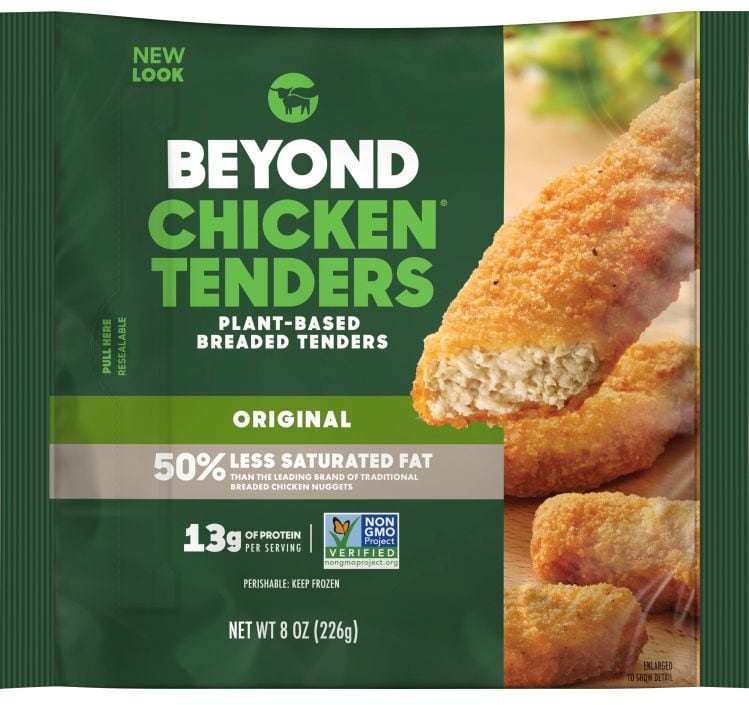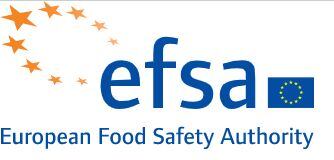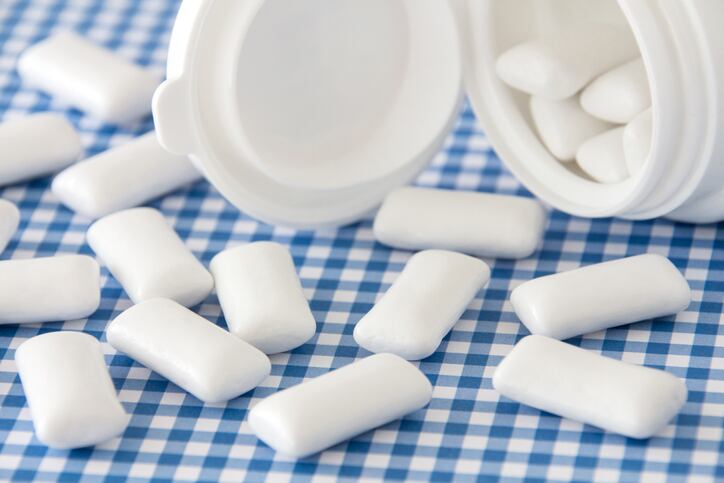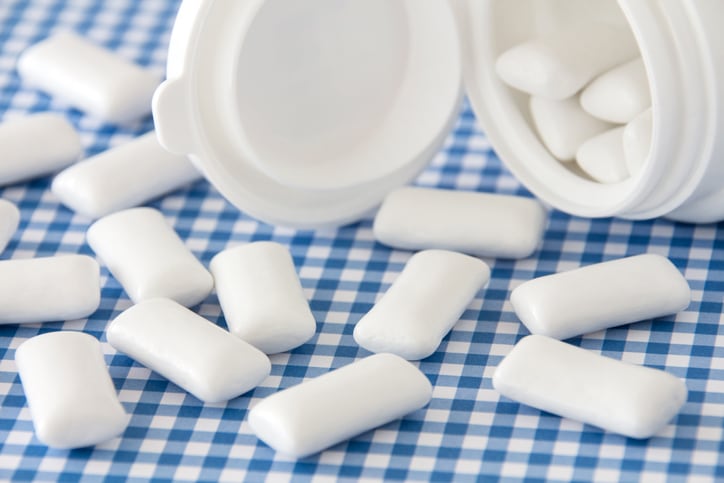TiO2 - a whitening and brightening pigment used in everything from gum to plant-based chicken - is approved as a color additive exempt from certification in the US, although several manufacturers have been attempting to phase it out for years as part of clean label commitments.
However, the ante was upped in May 2021 when the European Food Safety Authority (EFSA) issued a scientific opinion concluding that titanium dioxide (E171) “can no longer be considered safe as a food additive.”
Eight months later, the European Commission announced plans to ban it in foods by August 2022, prompting a series of putative class actions in the US challenging the presence of TiO2 in consumer products from Skittles (Mars) to Tylenol (Johnson & Johnson).
Earlier this month, consumer health advocacy group the Center for Science in the Public Interest (CSPI) added titanium dioxide to its list of food additives that shoppers should avoid, citing concerns that nanoparticles found in food-grade titanium dioxide (a white powder made up of small particles that whitens or brightens foods) may accumulate in the body and cause DNA damage.
However, regulators in Canada and the US have taken a different view.
Health Canada: ‘No conclusive scientific evidence that the food additive TiO2 is a concern for human health’
In June 2022, Health Canada issued a report reaffirming its opinion that there is “no conclusive scientific evidence that the food additive TiO2 is a concern for human health,” a view echoed by the FDA this month.
According to Health Canada, which conducted its “own comprehensive review of the available science” including “new scientific data that addressed some of the uncertainties identified by the EU expert panel and were not available at the time of their review,” many studies that raised safety concerns used forms of TiO2 “that are not considered acceptable for use in food and have different properties than food-grade TiO2.”

Other studies, said Health Canada, did use food-grade TiO2, “but took steps to break the material down into smaller particles than what would normally be found in food.”
Evidence also suggests that the toxicity of TiO2 particles may be reduced when eaten as part of the diet (as opposed to TiO2 administered alone) because proteins and other molecules can bind to TiO2 particles, altering their physical and chemical properties and impacting how they interact with cells, tissues and organs, argued Health Canada.
For example, adverse effects in the GI tract of lab animals given food-grade TiO2 directly were not seen when the same or higher doses were administered in the animals' diet (ie. in foods), noted Health Canada, which said its review found:
- no evidence of cancer or other adverse effects in mice and rats exposed to high concentrations of food-grade TiO2 (long-term or lifetime study);
- no changes to DNA in various animal studies;
- no adverse effects on reproduction, development, immune, gastrointestinal or nervous systems, or general health when rats were exposed from pre-conception to adulthood.
FDA: ‘The available safety studies do not demonstrate safety concerns connected to the use of titanium dioxide as a color additive’
Asked whether the FDA has looked again at Ti02 following the EC’s decision, a spokesman told FoodNavigator-USA: “The FDA reviewed the findings of EFSA’s 2021 Opinion on titanium dioxide and notes that EFSA’s 2021 Opinion continued to confirm no general and organ toxicity, as well as no effects on reproductive and developmental toxicity.
“In its 2021 Opinion, EFSA noted that it could not rule out genotoxicity and included genotoxicity tests on titanium dioxide nanomaterials. Some of the genotoxicity tests included test materials not representative of the color additive, and some tests included administration routes not relevant to human dietary exposure. The available safety studies do not demonstrate safety concerns connected to the use of titanium dioxide as a color additive.”
The spokesperson added: “The FDA continues to allow for the safe use of titanium dioxide as a color additive in foods generally according to the specifications and conditions, including that the quantity of titanium dioxide does not exceed 1% by weight of the food, found in FDA regulations at 21 CFR 73.575. “
Class action lawsuits: ‘Plaintiffs’ counsel may have been persuaded to drop the lawsuits given the clear defenses raised in Mars’ motions to dismiss’
As for lawsuits, while a report in any jurisdiction querying the safety of a food product or ingredient is likely to arouse the attention of plaintiff’s attorneys, the two high-profile lawsuits filed against Mars earlier this year over its use of Ti02 in Skittles this side of the Atlantic have both been voluntarily dismissed by the plaintiffs, according to court filings.
While this can often indicate that a case has been privately settled, legal experts following the cases (Thames v. Mars, Inc., 3:22-cv-04145 filed in California in July and Mignin v. Mars, Inc., 1:22-cv-04243 filed in Illinois in August), said the fact the dismissals were filed without prejudice (meaning the plaintiffs can sue again raising the same claims) meant a settlement was unlikely.
Kristine Kruger, senior counsel at law firm Perkins Coie told us: “Plaintiffs’ counsel may have been persuaded to drop the lawsuits given the clear defenses raised in Mars’ motions to dismiss.”
As to the strength of the defense waged by Mars (which argued that the claims are preempted by federal law and that the plaintiffs lack standing because they don’t plausibly allege they suffered economic or physical injury), she said: “If food and beverage companies follow the US regulations for products sold into the United States and their overall advertising and marketing is not otherwise deceptive, we believe companies have very solid defenses to the claims raised by these TiO2 plaintiffs.
“The preemption defense may be particularly helpful where, as is the case here, the FDA has issued regulations explicitly permitting and regulating the use of the substance at issue.”
An analogous example of this was the flurry of lawsuits filed in 2016 alleging foods were mislabeled and/or adulterated because they contained partially hydrogenated oils (which the FDA said were no longer Generally Recognized as Safe in 2015), a theory rejected by the courts because the FDA explicitly permitted PHOs in foods until a phase-out period ended in 2018, she said.
‘This is perhaps the end of consumer class action litigations challenging titanium dioxide in food products, at least for now…’
Sanjay Karnik, a senior trial counsel at law firm Amin Talati Wasserman, told us: “The plaintiffs in the Mars cases were facing an uphill battle pursuing their claims as pled, as the EFSA opinion and EC decision do not provide legal support for claims in the United States. Moreover, the fact that FDA approves TiO2 in the US market for use in food products, while not dispositive, created significant hurdles for the Plaintiffs.
“The FDA’s approval allowed Mars to assert early preemption defenses, which had strong legal support. Even absent preemption, without specific and plausible allegations of actual injury, the cases were likely to fail, whether at the pleading stage or a later stage of the proceedings.”
He added: “The two cases filed against Mars, Inc. appear to be the beginning and, as reflected in the dismissals of those cases, perhaps the end of consumer class action litigations challenging titanium dioxide in food products – at least for now.”
While TiO2 exposures are being litigated in California within the context of Proposition 65, he noted, “Prop 65 requires warnings only in cases of TiO2 exposure through inhalation of airborne, unbound particles of respirable size, and not through ingestion,” which means foods and beverages are not impacted.
Replacing titanium dioxide: A ‘high level of interest’ in North America, says Sensient
So what does this mean for food manufacturers?
While the FDA’s stance and the dismissal of the lawsuits may take some pressure off US firms currently using titanium dioxide in food, many firms still want to replace it if they can, David Rigg, global marketing director at Sensient, told us.
“Titanium dioxide replacement continues to be something customers are looking for globally. This is obvious for Europe where the colorant is no longer permitted, but we also see a high level of interest in other regions, especially North America.
“Sensient recently launched Avalanche Helio, a formulation specially created to provide opacity and whitening in retort applications like cream soups, sauces, and canned foods. We continue to work on improving the Avalanche line since there is no single perfect replacement for Titanium.”
As for cost in use, he said, it’s “improving, but remains higher than TiO2. This is mainly because alternatives require 2-10x the usage rate. But Sensient now has very cost effective starch- and mineral-based solutions for key applications such as panned confections, plant-based meat analogues, extruded applications, and other categories.”
ROHA USA: ‘TiO2 is a commodity product, requires low inclusion levels and has minimal interactions with components in food systems unlike its replacers’
Enver Ersen is application director at ROHA USA, which supplies pigments under the Niveous brand made from a variety of ingredients including starches, calcium carbonate, emulsifiers, and hydrocolloids, for use in everything from confectionery and beverages to plant-based foods and snacks.
“We are seeing the demand for titanium dioxide replacements increasing steadily,” he told us, but there are commercial and technical challenges: “TiO2 is a commodity product, requires low inclusion levels and has minimal interactions with components in food systems unlike its replacers."
‘Global brands will not want the label in the US to be considered ‘less safe’ then the EU label’
Fernando Arias, sales and marketing director at ROHA USA added: “Companies with sales in Europe have increased application development and plant trials. My opinion is that global brands will not want the label in the US to be considered ‘less safe’ then the EU label and this pressure will drive conversion in the USA.”
‘Food companies may lawfully use titanium dioxide as long as they do so within the bounds of 21 CRF 73.575’s requirements for use’
So what happens next?
William Acevedo, partner at law firm Stratagem, told us: “The Center for Food Safety has initiated a citizen petition requesting the FDA to ban all uses of titanium dioxide in food. That has not happened yet, and thus, food companies may lawfully use titanium dioxide as long as they do so within the bounds of 21 CRF 73.575’s requirements for use.”
While the titanium dioxide cases vs Mars have been dropped, and many of the lawsuits vs food companies over heavy metals in babyfood have been dismissed, added one legal source, this does not necessarily deter opportunistic plaintiff’s attorneys.
“So what they allege is you have a product that's got dangerous stuff in it, and you didn't tell me about it. Had you told me about it, I would have paid less or wouldn't have bought it at all.
“For some judges, that’s enough for a federal lawsuit. But the good news is enough judges are holding their feet to the fire and saying you don't have a lawsuit unless you can allege with facts that you are in imminent harm or you've been injured or that this really is dangerous stuff.”
There is also a thriving cottage industry whereby plaintiff’s attorneys will fire off demand letters in the hope of extracting money from food companies before a lawsuit is even filed, he noted, given that it’s cheaper to pay up than to defend a case once it has been filed, even if you are extremely confident that you will prevail.

Colors exempt from certification such as annatto extract and titanium dioxide include pigments from natural sources such as vegetables, minerals, or animals. They are not subject to batch certification requirements, but are still color additives and FDA must approve them before they can be used in foods.
Certified color additives such as FD&C Yellow No. 5 or FD&C Blue No. 1 are synthetic colorings that are required to undergo certification every time a new batch is manufactured.
Titanium dioxide (titanium and oxygen TiO2) is a naturally occurring mineral that is mined from the earth then further processed and purified for use in consumer products. In the US market, it is classified as a color additive exempt from certification provided inclusion rates don’t top 1% by weight of the food.
EFSA: ‘We could not rule out a concern for genotoxicity’

On May 6, 2021, the European Food Safety Authority (EFSA - which is a scientific advisory body, not a regulator) issued an updated evaluation taking into account “new scientific evidence and data on nanoparticles,” and concluded that titanium dioxide “can no longer be considered safe as a food additive."
Titanium dioxide “contains at most 50% of particles in the nano range [under 100 nanometers] to which consumers may be exposed,” explained EFSA, although constituent particles under 30 nanometers in size accounted for less than 1% of particles: “We could not exclude genotoxicity concerns after consumption of titanium dioxide particles. After oral ingestion, the absorption of titanium dioxide particles is low, however they can accumulate in the body."
Although no clear correlation was observed between the physico‐chemical properties of titanium dioxide particles and the outcome of in vitro or in vivo genotoxicity assays, EFSA concluded that the particles "have the potential to induce DNA strand breaks and chromosomal damage, although not gene mutations."
Professor Matthew Wright, chair of EFSA’s working group on titanium dioxide, added: “Although the evidence for general toxic effects was not conclusive, on the basis of the new data and strengthened methods we could not rule out a concern for genotoxicity and consequently we could not establish a safe level for daily intake of the food additive.”


